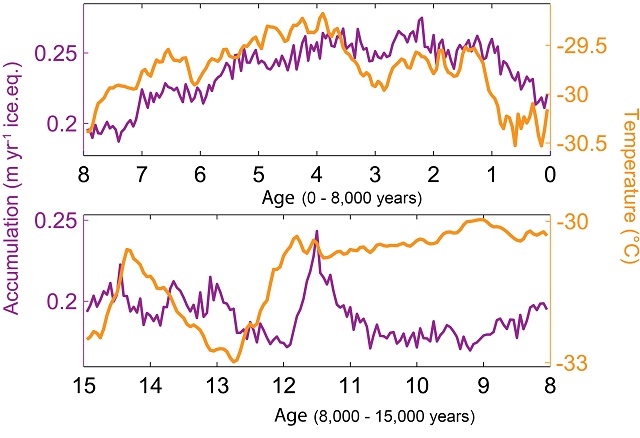Sea Level and Antarctic Snow Link Questioned
Some scientists believe that snowfall over Antarctica can mitigate the effects of sea level rise caused by thermal expansion of the world’s oceans, melting of snow and ice worldwide and the collapse of massive ice sheets. However, researchers from the University of Washington believe their analysis shows that temperature is an unreliable predictor of Antarctic snowfall.
Warmer air will hold more moisture and thus generate more snow to fall inland and slightly rebuild the glacier, according to climate model projections. Many climate models predict that warming temperatures will mean more snow in Antarctica in the future. When more snow falls inland at the upper edge of the flowing ice sheet, it counteracts mass lost to melting or calving at the edges. This extra snowfall would reverse two to four centimeters, or about one inch, of global sea-level rise by 2100, researchers said.
However, the researchers studied evidence from the West Antarctic Ice Sheet Divide ice core to get a first clear look at how the continent’s snowfall has varied over 31,000 years and found that warmer temperatures and snowfall sometimes go together, but often they don’t.
The 3.5-kilometer, or 2.1-mile, ice core preserves climate history in enough detail to show individual snow years.
In the more recent part of the record, at the top, the Antarctic air temperature (orange) and annual snow accumulation (purple) follow similar paths. But in the earlier part of the record, at the bottom, shifts in temperature and snowfall are often unrelated.
 Credit: T.J. Fudge/University of Washington
Credit: T.J. Fudge/University of Washington
For example, the record includes periods before 8,000 years ago, as Earth was coming out of its last ice age, when the air temperature went up by several degrees without any boost in the amount of snowfall.
“Our results make it clear that we cannot have confidence in projections of future snowfall over Antarctica under global warming,” said co-author Eric Steig, a University of Washington professor.
The large variation seen in the historical record probably reflects shifts in atmospheric patterns and how storm tracks reach Antarctica, T.J. Fudge, a postdoctoral researcher, said. Research is increasingly showing that winds play a big role in Antarctic temperature, sea ice and weather patterns, especially on shorter timescales, and that the gale-force winds that whip around the continent are connected to weather patterns in the tropics.

that matters most
Get the latest maritime news delivered to your inbox daily.
“For sea-level rise, we’re not really interested in what happens over thousands of years,” Fudge said. “We’re interested in what happens over the next few hundred years. At that shorter timescale, the variability in how the storms reach the continent matters much more than a few degrees of warming.
“By getting models to better capture the variability in our snowfall record, we actually will get a better idea of how the warm ocean is going to interact with the ice sheets at the edge, and those will have an even bigger impact on sea level, eventually,” Fudge said.
The opinions expressed herein are the author's and not necessarily those of The Maritime Executive.
